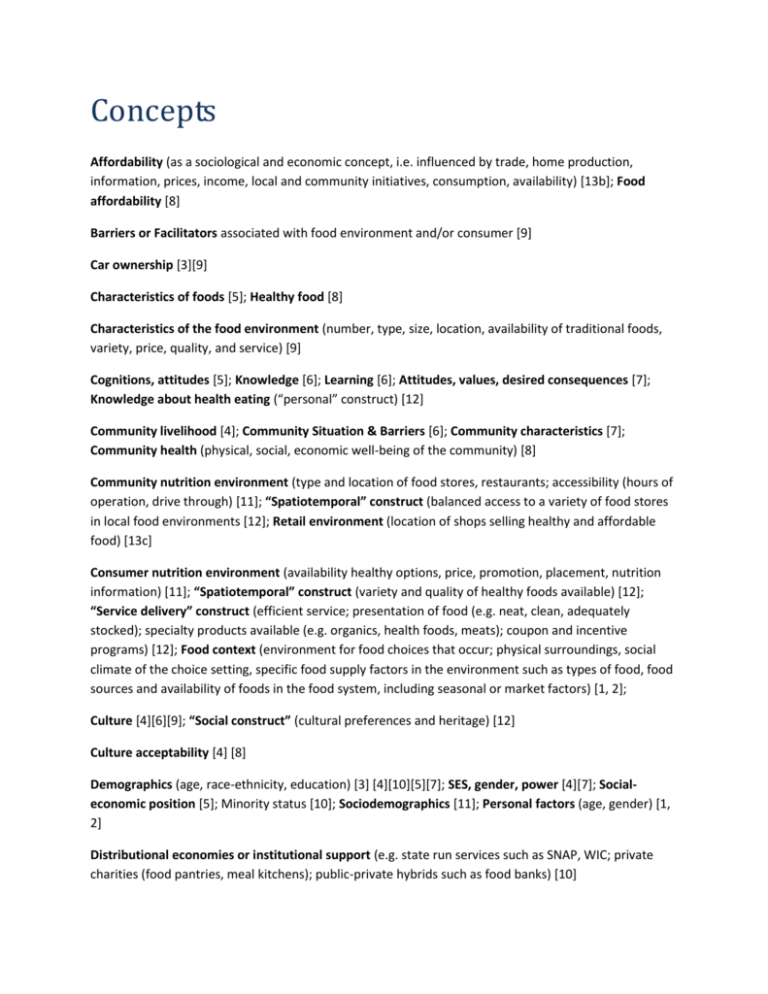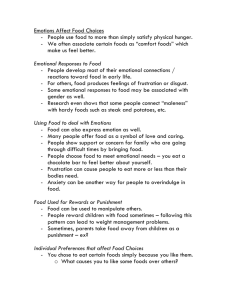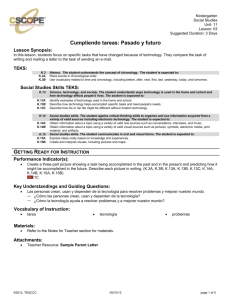Concepts Free List
advertisement

Concepts Affordability (as a sociological and economic concept, i.e. influenced by trade, home production, information, prices, income, local and community initiatives, consumption, availability) [13b]; Food affordability [8] Barriers or Facilitators associated with food environment and/or consumer [9] Car ownership [3][9] Characteristics of foods [5]; Healthy food [8] Characteristics of the food environment (number, type, size, location, availability of traditional foods, variety, price, quality, and service) [9] Cognitions, attitudes [5]; Knowledge [6]; Learning [6]; Attitudes, values, desired consequences [7]; Knowledge about health eating (“personal” construct) [12] Community livelihood [4]; Community Situation & Barriers [6]; Community characteristics [7]; Community health (physical, social, economic well-being of the community) [8] Community nutrition environment (type and location of food stores, restaurants; accessibility (hours of operation, drive through) [11]; “Spatiotemporal” construct (balanced access to a variety of food stores in local food environments [12]; Retail environment (location of shops selling healthy and affordable food) [13c] Consumer nutrition environment (availability healthy options, price, promotion, placement, nutrition information) [11]; “Spatiotemporal” construct (variety and quality of healthy foods available) [12]; “Service delivery” construct (efficient service; presentation of food (e.g. neat, clean, adequately stocked); specialty products available (e.g. organics, health foods, meats); coupon and incentive programs) [12]; Food context (environment for food choices that occur; physical surroundings, social climate of the choice setting, specific food supply factors in the environment such as types of food, food sources and availability of foods in the food system, including seasonal or market factors) [1, 2]; Culture [4][6][9]; “Social construct” (cultural preferences and heritage) [12] Culture acceptability [4] [8] Demographics (age, race-ethnicity, education) [3] [4][10][5][7]; SES, gender, power [4][7]; Socialeconomic position [5]; Minority status [10]; Sociodemographics [11]; Personal factors (age, gender) [1, 2] Distributional economies or institutional support (e.g. state run services such as SNAP, WIC; private charities (food pantries, meal kitchens); public-private hybrids such as food banks) [10] Educational factors [5][10] Environmental factors [5]; Environment (physical context—how rural or remote; types of crops that grow best; climate; topography; soil type) [8]; Environmental factors, agricultural factors [5][8] Exports; imports; storage [5] Food cost (as a function of in-store price + travel costs) [3]; Food price [13b] Food demand/supply (feedback loops – demand affects supply and supply shapes preferences) [3] [4] Food environments (stores, restaurants, schools workplaces, local policy) [4]; Organizational nutrition environment (home, work, school, healthcare facilities, churches, other) [11] Food store location [3]; Proximity [9]; “Spatiotemporal” construct (short distance to travel to stores) [12] Food store placement [3] Food supply (what is produced, how it is produced, food affordability—price and safety net) [4]; Food production [5]; Food system activities (producing, processing, packaging, distributing, retailing, consuming) [13a] Food-related lifestyles [7]; Meal preparation (knowledge and skills) [9]; Resources, intangible (knowledge, skills) [1, 2]; Eating patterns [11]; “Personal” construct (i.e. eating identity—healthy, picky, meat [12]; Personal system (negotiating such values as sensory perceptions, monetary considerations, convenience, health/nutrition, managing relationships, and quality) [1, 2] Frequency of shopping (can affect the environment’s effect on food choice) [11] Geography [4] Government & industry policies [11] Health beliefs [7] Health status (“personal” construct) [12]; Personal factors (health status) [1, 2]; Physical wellbeing [13c]; Individual health [9] Household situation & barriers [6]; Home environment (food storage, meal preparation area, refrigeration); Household size [9]; Resources, tangible (money, equipment (freeze, pantry), space) [1, 2] Ideals (expectations, standards, hopes and beliefs that are points of reference and comparison by which people judged and evaluated food choices) [1, 2] Income [3] [5]; Income (including benefits) [13b]; Financial resources (type, amount, timing) [9][12]; Household income [10] Individual livelihood [4]; Employment [9] Informal & Formal Support [6] Information environment (media, advertising) [11] In-store availability (shelf space, high concentration of certain foods, placement of foods) [3]; Food availability (supply) [4][8][9]; Availability as Potential Access [9] In-store characteristics (# of varieties, shelf space, placement) [3] In-store price [3]; Price tags of healthy foodstuffs (“economic” construct) [12] Life course [6]; Life course (personal roles, social and cultural, and physical environments to which a person has been exposed [1, 2] Local capacity for food (ability of local area to produce, import, and process food; local products, household gardens, community gardens) [8]; Global environmental change (land, climate, water, biodiversity, etc) [13a] Marketing [4] Neighborhood [9] Neighborhood segregation by race and class (“social” construct”) [12] Outgoing (as it relates to purchasing power) [13b] Perceived collective social functioning: perceived social capital & perceived personal disparity [10] Perceived nutrition environment [11]; Good value, food is worth the price [12] Physical access to food [13c] Physiological factors [5] Present Access (degree/level patterns) [9] Promotional effect [3] Psychosocial factors [4][11]; Personal situation & Barriers [6]; Public transportation [9]; Transport systems (their availability and an individual’s ability to access and afford those systems) [13c]; Regular and reliable access to transport (“spatiotemporal” construct) [12] Purchasing power [8][13b] Racism and sexism (institutional, personally mediated, internalized) (“social” construct”) [12] Reciprocal economies (receiving support from family or friends, e.g. sharing of food among friends, family members, neighbors and other community members; food may be from retail outlets, the distributional economy, hunting, or local gardens) [10] Relationship and connection to food system actors (“social” construct”) [12] Savings (as it relates to purchasing power) [13b] Social acceptability [3] Society & Economy [6]; Economy (flow of commerce in the area; production and distribution of goods and services; local jobs, retail establishments, entrepreneurial opportunities and lending institutions) [8]; Economics factors, policy considerations [5][8] Sociocultural factors [5]; Primary food shopper and preparer (affects eating patterns) [11]; Social framework (nature of interpersonal relationships within families/households, at work, entertaining, social roles and meaning) [1, 2] Socioeconomic drivers (changes in demographics, economics, socio-political context, cultural context, science and technology) [13a] Strategies (a feature of the personal system) (i.e. strategies that involved choice patterns based on previously resolved deliberations that had become habitual, heuristics) [1, 2] Taste and preferences [3][5][9]; Individual food choices [4]; Food choice [9]; Personal factors (likes/dislikes, individual food styles, food centeredness (pleasure, health, safety, or symbolism) and emotions (emotional cues, moods, and feelings), sensory preferences, taste sensitivities, cravings, state of hunger, preferences of particular food type, aversions, physiological factors like allergies) [1, 2] Time/time constraints (influence purchasing of away-from-home foods) [3] [4]; Work schedule (facilitates access, have time to shop (“spatiotemporal” construct)) [12]; Resource, intangible (time) [1, 2] Travel cost (as a function of availability of food stores + in-store availability) [3] Unequal access to food programs [10] Utilization as Realizes Access [9] References [1] Furst et al., 1996 conceptual model of food choice [2] Sobal & Bisogni, 2009 food choice process model [3] Rose et al., 2010 economic model of food consumption adapted to include neighborhood effects (3) [4] Neff et al., 2011 food system factors influencing disparities health (4) [5] Krebs-Smith & Kantor, 2001 factors influencing food choice (5) [6] Quandt, Arcury & Bell, 1998 nutritional self-management model (6) [7] Nie & Zepeda, 2011 Attitude-Behavior-Context (ABC) theory as an overall framework, and containing Means-end chain (MEC) theory, Health Belief (HB), and Food-related lifestyle (FRL) model (7) [8] Stubblefield et al., 2010 rural food system conceptual framework (8) [9] Sharkey et al., 2010 model for food access based on work in access to healthcare (9) [10] Dean & Sharkey 2011 Conceptual Model of food insecurity and determinants of access to food resources (10) [11] Glanz et al., 2005 model of community nutrition environments (11) [12] Freedman et al., 2010 developing a theory of food access (12) [13a] White et al., N.D. Global Environmental Change and Food Security Framework [13b] White et al., N.D. Conceptual model of affordability [13c] White et al., N.D. Conceptual model of physical access







